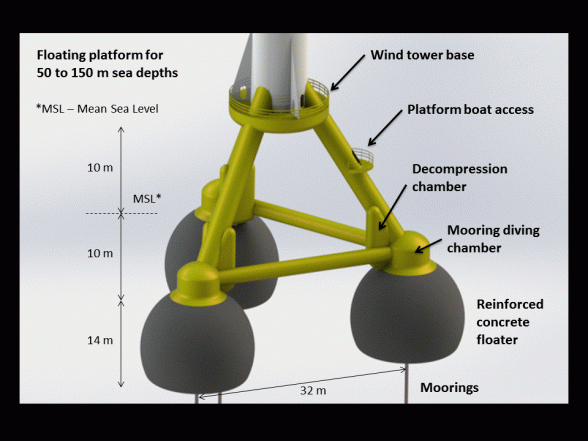The high total buoyancy of the floating platform is mainly achieved by the large volume of the three concrete floaters. These floaters have a spherical shape in order to maximize their volume while minimizing the area of wall needed. The bottom of the floaters is flat to facilitate the stand still of the structure in the construction yard, or while grounded in a harbor or in shallow waters. This flat surface is also needed to make the transition between the external spherical shape of the floater and the interior conical shape of the floater hole. This conical hole allows the moorings to cross the floater while allowing them also to sway. The oscillation of the mooring cables is essential to the platform stabilization.
After crossing the floater the mooring cable connect to the structure at the mooring chamber. Therefore ensuring the full compression of the concrete floater placed bellow. Because this chamber is closed, a bubble of compressed air will form, preventing the flooding of the chamber. Therefore, the mooring chamber becomes a diving bell. However the floaters are not very deep, therefore the air pressure inside the floaters will be small (about two or three atmospheres).
Because the air inside the mooring chamber needs always to be compressed (otherwise it will flood), this chamber will connect to the remaining structure through a bulkhead door leading to a decompression chamber. In this decompression chamber there are four more bulkhead doors; one leading to the inside of the floater, one leading to the space truss tube above this chamber and two leading to the two space truss tubes at each side of this chamber. This chamber allows therefore the division of the structure in sealed sections thus, preventing the spread of a possible flooding. The decompression chamber steel structure is also important to strengthen the structure at the crucial connection between the space truss tubes and the anchoring chamber.
In the decompression chamber the air compressors, air ventilators and water pumps are installed. The air compressors are needed to raise the air pressure allowing the access to the mooring chamber. After the air pressure may be lowered to allow the access to the other compartments. The air pressure should be lowered slowly if there is risk of decompression sickness. The air compressors are also needed to keep the pressure inside the mooring chamber high enough. Otherwise, the pressure inside this chamber would slowly drop because it is not 100% air tight.
The air ventilators are needed because the air inside the sealed compartments needs to be renovated to prevent the CO2 concentration to rise too high. The ventilators are also important to control the air relative humidity.
The water pumps allow the extraction of water from inside the structure if there is a flooding. Inside the floaters the water pumps circuit may be reversed in order to pump water into them. This water is used as ballast weight during the platform installation or any platform operation that may require a change in the platform elevation or a correction of the platform verticality.
The mooring and decompression chambers of the three floaters are connected to the base of the wind tower by a steel space truss made by three horizontal tubes and three inclined tubes.

